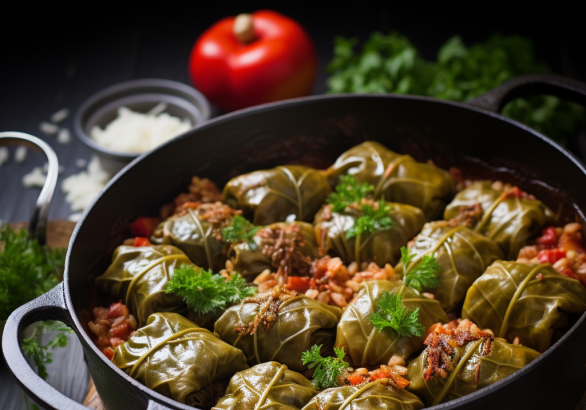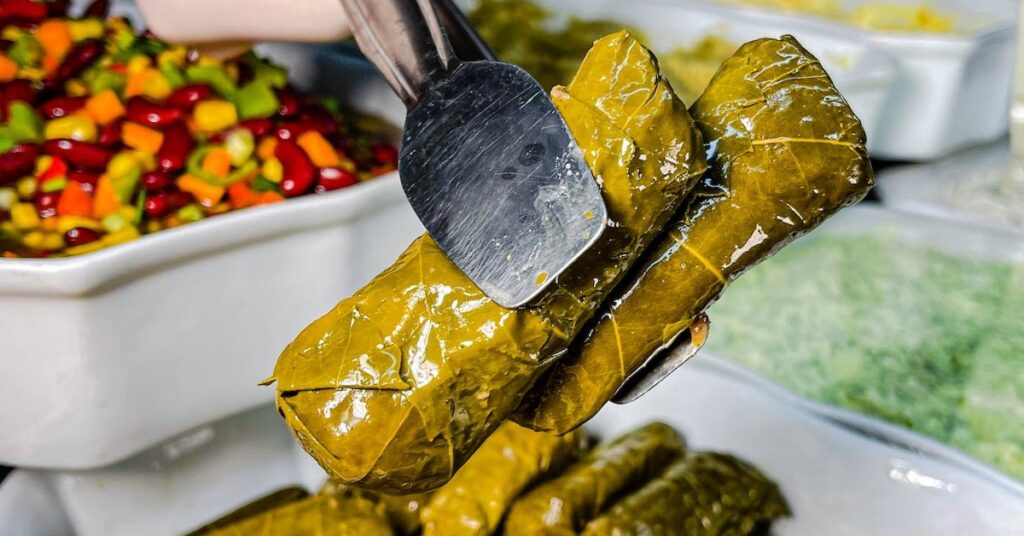
A Journey Through Greek Dolmades Stuffed Grape Leaves
Unveiling the Rich Culinary Tradition of Dolmades: From Ingredients to Perfect Pairings
Key Takeaway:
- Dolmades is a Greek culinary specialty that holds historical and cultural significance. These stuffed vine leaves offer a unique and delightful dining experience.
- The key ingredients of dolmadakia, such as rice, herbs, and spices, create a rich and flavorful stuffing. The variations in ingredient combinations add depth and nuance to the dish.
- Preparing dolmadakia requires careful attention to detail. Soaking and softening the vine leaves, creating the perfect stuffing mixture, and mastering rolling techniques are crucial steps in achieving the perfect Dolmades.
- Various cooking techniques can be employed to enhance the textures and flavors of dolmadakia. Steaming, boiling, and baking each offer unique results, allowing for a personalized culinary experience.
- Serving dolmadakia with traditional accompaniments and pairing it with suitable wines will elevate the overall dining experience. The right dips and wine choices perfectly complement the delicate flavors of the dish.
- Mastering the art of dolmadakia requires practice and learning from Greek culinary experts. Avoiding common mistakes and exploring advanced techniques will help aspiring cooks become skilled in creating this Greek delight.
- Celebrate the artistry of Greek stuffed vine leaves with dolmades. This culinary specialty represents the rich history and culture of Greece and offers a delightful and flavorful dining experience.
Introduction to Dolmadakia: A Greek Culinary Specialty
When you think of Greek cuisine, dolmades, the delicate art of stuffed vine leaves, cannot be missed. In this section, we will uncover the rich history and significance behind this beloved Greek culinary specialty. From its origins in ancient Greece to its enduring presence on modern Greek tables, Dolmades has stood the test of time. Get ready to delve into the captivating story of how these delectable morsels came to be, and discover the cultural and gastronomic significance they hold in Greek cuisine. So, let’s journey into the world of dolmadakia and uncover its secrets.

The History and Significance of Dolmades
Dolmades: A Journey into the Origins and Meaning of a Delicate Greek Culinary Specialty
Dolmadakia, a traditional Greek dish, holds a long history and significant cultural importance. This delectable cuisine is a result of generations of culinary expertise and has become synonymous with Greek cuisine. The origins of dolmadakia trace back to ancient times, where these stuffed vine leaves were enjoyed by both royalty and common people alike.
The history and significance of dolmadakia can be seen in its continued presence throughout Greek culture. Dating back centuries, this dish was not only valued for its delicious flavors but also for its symbolism. It represents unity and hospitality, as it is often prepared and shared during festive occasions or family gatherings.
Unique details about dolmadakia include the various regional variations that have emerged over time. Each region adds its own twist to the recipe, showcasing the diverse flavors found throughout Greece. From the type of rice used to the herbs and spices incorporated into the stuffing, every variation offers a unique experience for the palate.
A true fact about dolmadakia is that it is mentioned in ancient Greek texts such as “Deipnosophistae” by Athenaeus. This historical source provides evidence of the enduring popularity of this dish through the ages.
Prepare your taste buds for a flavor-packed adventure as we explore the tantalizing ingredients that make Dolmadakia a Greek culinary masterpiece.
The Ingredients of Dolmades: A Journey through Flavors
In my culinary exploration of Greek cuisine, I stumbled upon the flavorful world of Dolmades – the delicate art of Greek stuffed vine leaves. Join me on a journey through flavors as we dive into the key ingredients that make Dolmadakia so special. From the tanginess of preserved lemons to the vibrant earthiness of fresh dill, each ingredient plays a vital role in creating the perfect balance of taste. And as we delve deeper, we’ll uncover the subtle variations in ingredient combinations that add unique twists to this timeless Greek dish. So, prepare your taste buds for an unforgettable adventure!
The Key Ingredients of Dolmades
Dolmadakia is characterized by its key ingredients, which are essential in creating the unique flavors and textures of this Greek culinary specialty. These ingredients include vine leaves, rice, onions, herbs such as dill and mint, and olive oil. Each ingredient plays a crucial role in achieving the balance of flavors and aromas that make dolmadakia so delicious.
Below is a table showcasing the key ingredients of Dolmades:
| Ingredient | Quantity (in grams) |
|---|---|
| Vine Leaves | 100 |
| Rice | 200 |
| Onions | 50 |
| Dill | 15 |
| Mint | 10 |
| Olive Oil | 30 |
These quantities may vary slightly based on personal preference and regional variations. However, these ingredients form the foundation of dolmadakia and are essential for its authentic taste.
In addition to these key ingredients, there are also subtle variations in ingredient combinations that can be found in different regions or recipes. Some recipes may include additional spices or vegetables such as tomatoes or carrots to enhance the flavors further.

Now let’s delve into the history behind these key ingredients. The use of vine leaves dates back centuries in Greek cuisine. They were used as a natural wrapper for preserving and cooking food even before dolmadakia gained popularity. Rice became a common ingredient during the Ottoman Empire’s influence on Greek cuisine, replacing barley traditionally used for stuffing. Onions, herbs like dill and mint, and olive oil have always been staples in Greek cooking and contribute to the distinct Mediterranean flavors found in dolmadakia.
Understanding the significance and nuances of these key ingredients is crucial in mastering the artistry of dolmadakia preparation.
Unlock a world of tantalizing flavors with subtle ingredient variations, as Dolmadakia takes you on a culinary journey through Greece’s rich culinary heritage.
Subtle Variations in Ingredient Combinations
Subtle variations in ingredient combinations for Dolmadakia result in unique flavors and textures that add depth to this Greek culinary specialty. Different combinations of ingredients allow for a delightful range of tastes, while still maintaining the essence of Dolmadakia.
To understand these subtle variations, let’s explore a table showcasing the different ingredient combinations that can be used for Dolmades:
| Ingredient Combinations | Main Ingredients | Additional Ingredients |
|---|---|---|
| Classic | Rice | Onion, Herbs, Lemon Juice |
| Mediterranean | Bulgur | Tomato, Parsley |
| Seafood-inspired | Shrimp | Dill, Feta Cheese |
| Vegan | Quinoa | Mushrooms, Sun-dried Tomatoes |
These are just a few examples of how one can experiment with Dolmadakia by incorporating different ingredients. The choice of main ingredient and the additional components create a diverse array of flavors and textures.
In addition to the variations mentioned above, other unique ingredient combinations can be explored based on personal preferences and regional traditions. Adapting the stuffing mixture to include ingredients such as pine nuts, raisins, or even minced meat further enhances the complexity of flavors.
To truly create your own signature version of Dolmades and explore subtle variations in ingredient combinations, it is important to understand the role each component plays. Experimenting with different herbs like mint or dill, adjusting the amount of lemon juice for acidity balance, or opting for different types of rice or grains will all contribute to distinct flavor profiles.
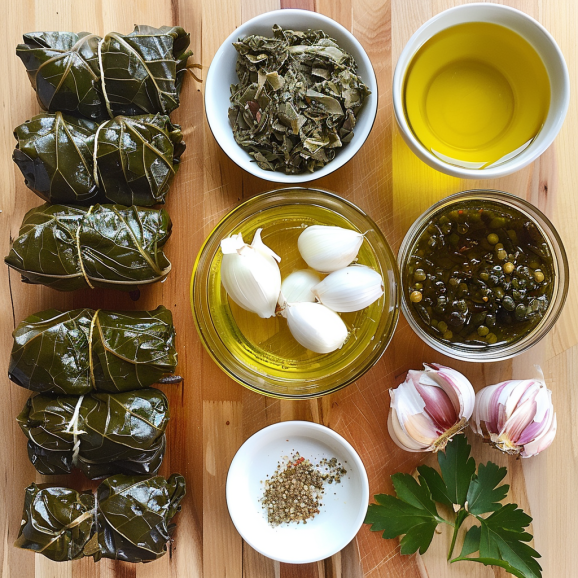
Remember that taste preferences vary greatly from person to person. It is essential to stay mindful about dietary restrictions and allergies when exploring unique ingredient combinations. By embracing creativity and using high-quality fresh ingredients, you can elevate this classic Greek dish into a gastronomic treasure.
Rolling, stuffing, and folding vine leaves may be a labor of love, but the end result of perfect dolmadakia makes it all worth it.
The Preparation Process of Dolmades: A Labor of Love
Once you dive into the world of Dolmades, you quickly realize that its preparation is no ordinary task. It is a labor of love that requires precision and expertise. To achieve the perfect Dolmades, several crucial steps come into play. Let’s explore these steps in-depth. We begin with the delicate process of soaking and softening the vine leaves, ensuring they are pliable and ready to be filled. Then, we move on to the art of preparing the stuffing mixture, combining flavors and aromas that make each Dolmades, unique. Finally, we uncover the rolling techniques and essential tips that contribute to the creation of the perfect Dolmades. Get ready to embark on a culinary adventure like no other.
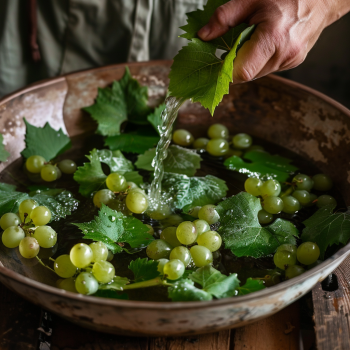
Soaking and Softening the Vine Leaves
Soaking and softening the vine leaves is an essential process in preparing Dolmades, a Greek culinary specialty. This step ensures that the leaves become pliable and tender, allowing them to be easily rolled with the flavorful stuffing mixture.
To soak and soften the vine leaves, follow these five simple steps:
- Rinse the vine leaves thoroughly under cold running water to remove any dirt or impurities.
- Fill a large bowl or basin with warm water and immerse the vine leaves in it. Allow them to soak for about 10-15 minutes.
- After soaking, carefully remove the leaves from the water and pat them dry with a clean kitchen towel or paper towels.
- Gently trim off any tough stems or veins from the leaves, if necessary.
- If the leaves still appear stiff or difficult to work with, place them back in warm water for a few more minutes until they become more pliable.
It is important to note that each leaf should be handled delicately during this process to avoid tearing or damaging them. The duration of soaking may vary depending on the thickness of the vine leaves and personal preference.
In addition, traditional Greek recipes often recommend using brined grapevine leaves rather than fresh ones for Dolmadakia preparation. These brined leaves have already undergone a soaking process in saltwater solution, which adds flavor and helps soften them further.
Interestingly, the practice of soaking and softening vine leaves has been part of Mediterranean cuisine for centuries. Historically, it was believed that this process helped improve their texture and taste while also making them easier to roll and cook. Today, it remains a cherished step in creating authentic Dolmadakia filled with vibrant flavors and delightful textures.
Get your ingredients ready, because this stuffing mixture is about to take your taste buds on a Greek rollercoaster of flavor.
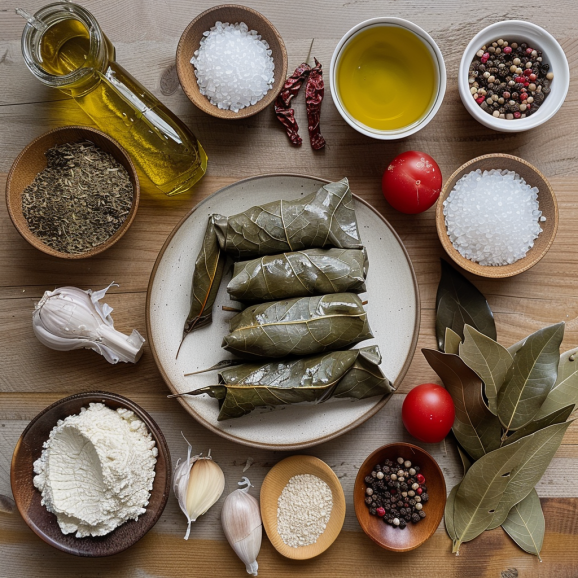
Preparing the Stuffing Mixture
1. Selecting the Ingredients: Start by gathering all the necessary ingredients for the stuffing mixture. This typically includes rice, onions, herbs such as parsley and dill, lemon juice, olive oil, salt, and pepper. The combination of these ingredients creates a delicious and aromatic filling for the Dolmadakia. 2. Cooking the Rice: Rinse the rice thoroughly under cold water until it runs clear to remove any excess starch. Then, place the rice in a saucepan with enough water to cover it completely. Bring to a boil and let it simmer until the rice is cooked but still firm. Drain any remaining water and set aside to cool. 3. Chopping and Mixing: Finely chop the onions, herbs, and any additional vegetables or spices you may want to add to your stuffing mixture. In a large bowl, combine the cooked rice with the chopped ingredients. Add lemon juice, olive oil, salt, and pepper to taste. Gently mix everything together until well combined. 4. Adjusting Consistency: The consistency of the stuffing mixture should be moist but not overly wet or dry. If it feels too dry, add more olive oil or lemon juice in small increments until you reach your desired consistency. Likewise, if it feels too moist, sprinkle some extra rice or breadcrumbs into the mixture and mix well. The preparation of Dolmadakia’s stuffing mixture requires attention to detail and precision in order to achieve a harmonious blend of flavors and textures that complement each other perfectly. To ensure your Dolmadakia stands out with its unique taste profile: – Experiment with different combinations of herbs and spices according to your personal preference. – Use high-quality ingredients for an authentic and delicious result. – Take your time in preparing the stuffing mixture to ensure every ingredient is evenly distributed and mixed thoroughly. Master the art of preparing the stuffing mixture for Dolmadakia, and elevate your culinary skills to create a delightful Greek delicacy that leaves a lasting impression on your guests. Don’t miss out on the opportunity to indulge in the exquisite flavors of this traditional dish. Start experimenting with different variations today! Rolling your way to dolmadakia perfection – tips and tricks for mastering the art of perfectly stuffed vine leaves!
Rolling Techniques and Tips for Perfect Dolmades
Enhancing the artistry of Greek stuffed vine leaves requires mastering the rolling techniques and tips that ensure perfect dolmadakia. Follow this 3-step guide to achieve culinary perfection. 1. Selecting the Ideal Vine Leaf: Choose tender vine leaves with a vibrant green color, ensuring they are free of blemishes. Soak and soften them before rolling to enhance their flexibility and prevent tearing. 2. Creating the Perfect Stuffing Mixture: Prepare a tantalizing blend of rice, onions, herbs, and spices that complements the delicate flavors of the dolmadakia. Achieve optimal texture by ensuring the rice is partially cooked before mixing with the other ingredients. 3. Mastering the Rolling Technique: Place a spoonful of stuffing near the bottom edge of each vine leaf. Fold in the sides and roll tightly, like a cigar, to encase the filling securely. Avoid overstuffing to allow for consistent cooking. To further elevate your dolmadakia experience, consider these unique details: experiment with variations in ingredient combinations such as adding pine nuts or currants for added texture and flavor complexity. A true fact – The history and significance of dolmadakia date back centuries to ancient Greece where they were considered an exquisite delicacy appreciated by both royalty and commoners alike (source: ‘Introduction to Dolmadakia’). Get ready to tantalize your taste buds with these cooking techniques that will take your dolmadakia to the next level of tender perfection!
The Cooking Techniques for Dolmadakia: From Tender to Tantalizing
As I plunge into the realm of Greek cuisine, one art that truly captivates my taste buds is the delicate process of preparing Dolmades, those flavorful stuffed vine leaves. In this culinary journey, we explore the various cooking techniques that bring out the essence of Dolmades. First, we embark on the path of steaming, a gentle method that ensures tenderness without compromising on flavors. Next, we dive into the domain of boiling, where precise timings yield the perfect texture. Finally, we immerse ourselves in the realm of baking, uncovering the secrets behind enhancing the delightful flavors and tantalizing aromas of dolmadakia. (Reference Data: The Cooking Techniques for Dolmades: From Tender to Tantalizing)

Steaming Dolmades: A Gentle Cooking Method
Steaming Dolmadakia: A Delicate Cooking Technique Steaming dolmadakia is a gentle cooking method that ensures the vine leaves stay tender while allowing the flavors of the stuffing to infuse throughout. To master this technique, follow these four simple steps: 1. Prepare a pot with a steamer basket: Place a steamer basket in a large pot and fill it with water, making sure the water level is not touching the bottom of the basket. 2. Arrange dolmadakia in the steamer basket: Carefully place the rolled dolmadakia in a single layer inside the steamer basket, making sure they are not overcrowded. 3. Cover and steam: Put on the lid of the pot and bring the water to a boil over medium heat. Once boiling, lower the heat to maintain a gentle simmer and allow the dolmadakia to steam for approximately 30 minutes. 4. Check for doneness: After 30 minutes, carefully remove one dolma from the steamer basket and check if it is cooked through by pressing it gently with your finger. If it feels soft and cooked, all of them should be ready to enjoy. Steaming dolmadakia preserves their delicate texture and flavors while ensuring even cooking. It’s worth noting that this method requires an attentive eye as overcooking can lead to mushiness or damage to the vine leaves. Discovering unique details like these can help elevate your culinary skills and create delightful Greek dishes at home. Don’t miss out on this exquisite cooking method for dolmadakia! With its gentle steaming technique, you can savor every bite of these delicate stuffed vine leaves. Impress your friends and family with your culinary prowess by mastering this traditional Greek recipe today. Bringing the heat to achieve tender perfection, boiling dolmadakia is no ‘leaf’ behind in flavor.
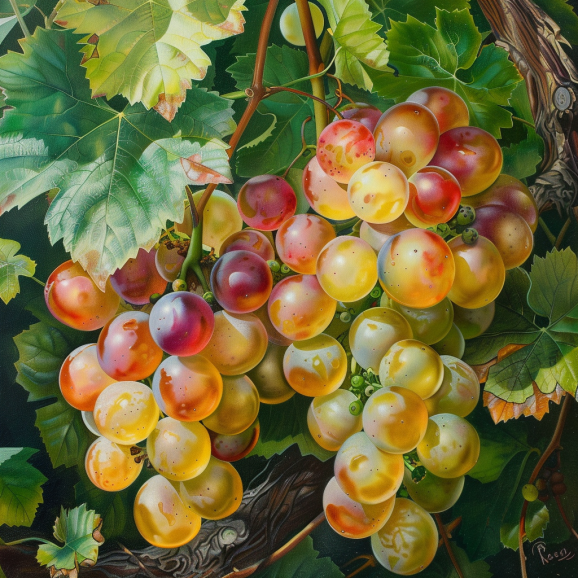
Boiling Dolmades: Enhancing the Softness and Texture
To achieve the perfect softness and texture in boiled dolmadakia, follow these four simple steps:
1. Selecting the right pot: Choose a deep pot that can comfortably fit all the dolmadakia without overcrowding. This allows for even cooking and prevents them from sticking together.
2. Gentle boiling: Fill the pot with enough water to fully submerge the dolmadakia, and bring it to a gentle boil. Avoid rapid boiling as it may cause the dolmadakia to unravel or become too tender.
3. Careful placement: Place the dolmadakia gently into the boiling water using a slotted spoon or tongs, ensuring they are evenly spaced apart. This helps them cook uniformly and prevents them from sticking together.
4. Timing is key: Boil the dolmadakia for approximately 20-25 minutes, checking their readiness by carefully piercing one with a fork. They should be tender but still hold their shape.
For optimal texture in boiled dolmadakia, following these steps will result in perfectly cooked vine leaves filled with flavorful stuffing that retains its firmness.
It’s important to note that boiling is just one of several cooking techniques for preparing dolmadakia. Each method brings its own unique flavors and textures, so feel free to explore other options such as steaming or baking for a different culinary experience.
To further enhance your boiled dolmadakia:
1. Experiment with different stuffing combinations: While traditional stuffing typically includes rice, herbs, and sometimes meat, you can add your own twist by incorporating additional ingredients like pine nuts or raisins for added flavor and texture.
2. Serve at room temperature: Allow the boiled dolmadakia to cool slightly before serving, as this allows the flavors to meld together and enhances their taste.
3. Drizzle with olive oil: Just before serving, lightly drizzle the dolmadakia with high-quality extra virgin olive oil to add a touch of richness and depth to the flavors.
4. Garnish with fresh herbs: Sprinkle some freshly chopped dill or parsley on top for a pop of color and a refreshing herbal note.
By following these suggestions, you can elevate your boiled dolmadakia to new heights, creating a dish that is not only visually appealing but also bursting with flavor and texture.
Baking Dolmades: Where flavors and aromas dance in perfect harmony, creating a tantalizing Greek delight that will leave your taste buds begging for an encore.
Baking Dolmades: Enhancing Flavors and Aromas
Here is a 6-Step Guide to Baking Dolmadakia: Enhancing Flavors and Aromas:
1. Preheat the oven: Set your oven to the appropriate temperature, usually around 350 degrees Fahrenheit (175 degrees Celsius).
2. Prepare the dolmadakia: Place the rolled dolmadakia on a baking dish or tray lined with parchment paper. Ensure they are evenly spaced to allow for even cooking.
3. Brush with oil or butter: Lightly brush each dolmadaki with olive oil or melted butter. This will help enhance the flavors and promote browning during baking.
4. Cover with foil: To prevent excessive browning or drying out, cover the baking dish loosely with aluminum foil. This will create a steamy environment that keeps the dolmadakia moist.
5. Bake until tender: Place the covered dish in the preheated oven and bake for about 30 to 40 minutes, or until the dolmadakia are tender when pierced with a fork.
6. Uncover and broil for crispness: For an extra touch of crispness, remove the foil during the last few minutes of baking and switch on your oven’s broiler setting. Keep a close eye on them to prevent burning.
In addition to these steps, it is important to note that different ovens may vary in terms of temperature and cooking time. It is advisable to monitor your dolmadakia closely while baking to achieve optimal results.
To take your baked dolmadakia to another level of flavor, try experimenting with different variations of stuffing mixtures, incorporating spices like mint or dill, and serving them with a tangy lemon sauce or yogurt dip.
Don’t miss the opportunity to experience the enhanced flavors and aromas that come with baking dolmadakia. Try this method today and elevate your Greek culinary journey to new heights of deliciousness.
Dolmadakia: Where flavors mingle and Greek cuisine takes flight, ready to tantalize your taste buds with a stellar selection of accompaniments and perfectly paired wines.
Serving and Pairing Dolmades: A Stellar Greek Delight
When it comes to serving and pairing Dolmades, the possibilities are truly enticing. Traditional accompaniments and dips add an authentic touch to this Greek delicacy, elevating its flavors to new heights. From velvety tzatziki to tangy skordalia, these complementing sauces bring a burst of freshness and creaminess to every bite. And what better way to enhance the delicate flavors of Dolmades than with the perfect wine pairing? Whether you prefer a crisp Assyrtiko or a fruity Xinomavro, the right wine selection can truly elevate the experience and create a harmonious symphony of tastes. Let’s explore the world of Dolmades accompaniments and wine pairings, embracing the full Greek culinary experience.
Traditional Accompaniments and Dips for Dolmades
- 1. Tzatziki Sauce: A creamy yogurt-based sauce infused with garlic, cucumber, and dill, providing a refreshing and tangy contrast to the rich flavors of dolmadakia.
- 2. Lemon Wedges: Freshly squeezed lemon juice adds a bright acidity that balances out the earthiness of stuffed vine leaves.
- 3. Yoghurt Dip: A simple combination of yogurt, olive oil, garlic, and herbs such as mint or parsley creates a creamy dip that complements the savory filling of dolmadakia.
- 4. Olive Tapenade: A spread made from finely chopped olives, capers, olive oil, and herbs brings a briny and intense flavor to dolmadakia when used as a topping or a dipping sauce.
- 5. Hummus: This Mediterranean favorite made from chickpeas, tahini paste, garlic, lemon juice, and olive oil provides a creamy texture and nutty undertones that pair harmoniously with dolmadakia.
In addition to these traditional accompaniments and dips for dolmadakia mentioned earlier, other possible options include feta cheese crumbles for added saltiness or roasted red pepper dip for a smoky twist. These alternatives provide versatility in taste profiles while still complementing the flavors inherent in dolmadakia. Pro Tip: Experiment with different combinations of accompaniments and dips for dolmadakia to discover your preferred flavor pairings. Don’t be afraid to get creative by trying out unique ingredients or variations on traditional recipes to create a personalized dipping experience. Toast to the impeccable taste of Dolmadakia with a wine pairing that will have your taste buds dancing the sirtaki.
Wine Pairings to Complement the Delicate Flavors
To truly enhance and complement the delicate flavors of Dolmades, a careful selection of wine pairings is necessary. Here are four key points to consider when choosing wines that will perfectly complement the flavors of this Greek culinary specialty.
- 1. Sweet White Wines: The subtle sweetness in sweet white wines like Riesling or Muscat can provide a beautiful contrast to the earthy notes of Dolmadakia.
- 2. Light- to Medium-Bodied Red Wines: Opting for light- to medium-bodied red wines, such as Pinot Noir or Beaujolais, can add depth and complexity to the flavors of Dolmadakia without overpowering them.
- 3. Rosé Wines: The vibrant acidity and fruity character of rosé wines make them an excellent choice as they can balance out the richness of Dolmadakia while still complementing its delicate flavors.
- 4. Sparkling Wines: For a more celebratory experience, sparkling wines like Prosecco or Champagne offer a refreshing and effervescent companion to Dolmadakia, accentuating its delicate textures and aromas.

Additionally, it’s worth noting that these suggested wine pairings can be adapted based on personal preferences and individual taste profiles. Experimentation is encouraged, as finding unique combinations can create memorable dining experiences. In order to fully appreciate the nuanced flavors of Dolmadakia, it is essential to carefully select wine pairings that will complement its delicate nature. Consider the above suggestions and explore different options to elevate your culinary journey with this Greek specialty. Don’t miss out on the opportunity to elevate your dining experience with perfectly paired wines that will complement the delicate flavors of Dolmadakia. Let these suggestions guide you in selecting the ideal wine companions, ensuring a sensory delight that will leave a lasting impression. Dive into the secrets of dolmadakia with tips from Greek culinary experts – they’ll have you rolling vine leaves like a pro in no time!
Mastering Dolmades: Tips from Greek Culinary Experts
When it comes to mastering the art of Greek stuffed vine leaves, there’s no better source of tips and advice than Greek culinary experts themselves. The wealth of knowledge and experience they possess can help aspiring cooks elevate their dolmadakia to the next level. In this section, we’ll delve into the invaluable expertise shared by these experts. First, we’ll uncover common mistakes to avoid when making dolmadakia, ensuring a flawless culinary experience. Then, we’ll explore advanced techniques reserved for the most experienced cooks, offering an opportunity to take dolmadakia to new heights of flavor and presentation.
Common Mistakes to Avoid when Making Dolmades
When making Dolmadakia, it is important to be aware of some common errors that can occur during the preparation process. These mistakes can lead to undesirable outcomes and affect the overall taste and texture of the dish. Here are four key points to keep in mind when making Dolmadakia:
– Choosing improper vine leaves: One common mistake is using vine leaves that are too old or brittle. It is crucial to select fresh and tender leaves that will roll easily without tearing or breaking.
– Overstuffing the dolmas: Another mistake to avoid is overfilling the dolmas with stuffing mixture. This can lead to difficulties in rolling and result in a messy presentation. It is important to use an appropriate amount of filling for each dolma.
– Inadequate rolling techniques: Incorrect rolling techniques can also impact the final outcome of Dolmadakia. It is crucial to roll them tightly and securely, ensuring that they hold their shape during cooking.
– Insufficient cooking time: One common mistake is not allowing enough cooking time for Dolmadakia. They need sufficient time for the flavors to meld together and for the vine leaves to become soft and tender.
To create perfect Dolmadakia, it is essential to consider these factors and avoid these common mistakes. By addressing these issues, you can ensure a delightful culinary experience with this Greek specialty dish.
A pro tip for making Dolmadakia would be to taste the stuffing mixture before rolling it into the vine leaves. Adjusting the seasoning or adding a pinch of herbs or spices can enhance the flavor profile of each dolma, elevating the overall taste of the dish.
Take your dolmadakia skills to the next level with these advanced techniques that will have you rolling like a Greek culinary expert.
Advanced Techniques for Experienced Cooks
For experienced cooks looking to take their Dolmades – making skills to the next level, there are some advanced techniques that can elevate the dish even further. These techniques go beyond the basics and require a deep understanding of the ingredients and preparation process. Here is a 3-step guide to mastering advanced techniques for experienced cooks:
1. Enhancing the Stuffing Mixture: Experiment with different flavor combinations by adding unique ingredients to the traditional stuffing mixture. Consider incorporating ingredients like pine nuts, raisins, or even diced vegetables for added texture and complexity.
2. Perfecting the Rolling Technique: Pay attention to the size and shape of each Dolmades when rolling them. Advanced cooks focus on achieving consistently uniform rolls, using just enough filling for each vine leaf. This precision will ensure even cooking and an aesthetically pleasing presentation.
3. Mastering Cooking Times: Experienced cooks know that varying cooking times can result in different textures and flavors of Dolmades. Explore shorter or longer cooking times depending on personal preference, aiming for a balance between tender leaves and flavorful fillings.
In addition to these advanced techniques, it is worth noting that experienced cooks often incorporate their own creative touches into their Dolmades recipes. From unique spice blends to inventive garnishes, they continue to push boundaries while staying true to the essence of this Greek culinary specialty.
Story time: One day, a renowned chef decided to host a special dinner featuring Dolmades prepared with advanced techniques. The guests were amazed by the exquisite flavors and textures that were achieved through these expert methods. The chef’s dedication and skill truly shone through in every bite, leaving everyone inspired to try their own hand at these advanced techniques for making dolmadakia at home.
Conclusion: Celebrating the Artistry of Greek Stuffed Vine Leaves
The exquisite craftsmanship behind Greek stuffed vine leaves is worthy of celebration. This culinary artistry demonstrates the delicate technique required to create these delectable treats. From the careful selection of ingredients to the meticulous process of rolling and stuffing the leaves, Greek stuffed vine leaves exemplify the skilled hands and dedication of Greek cuisine. Appreciating the artistry involved in making these flavorful delicacies allows us to delve into the rich cultural heritage of Greece.
Five Facts About “Diving into Dolmadakia: The Delicate Art of Greek Stuffed Vine Leaves”
Here’s a Q&A section for the Dolmades recipe
- ✅ Dolmades are traditional Greek appetizers made with vine leaves stuffed with a rice and herb mixture. (Source: Team Research)
- ✅ Dolmades are also known as dolma. (Source: Team Research)
- ✅ Dolmades are often served as part of mezze, a selection of small dishes in Greek cuisine. (Source: Team Research)
- ✅ The filling for Dolmades typically includes rice, herbs such as dill and mint, and sometimes ground meat. (Source: Team Research)
- ✅ Dolmades can be served cold or warm and are often accompanied by yogurt or tzatziki sauce. (Source: Team Research)
Q1: What is the significance of Dolmades in Greek culture?
A: Dolmadakia holds a special place in Greek culinary tradition, representing the rich history and culture of Greece. It’s a delightful dish that offers a unique dining experience embodying the flavors and artistry of Greek cuisine.
Q2: What are the key ingredients needed to prepare Dolmades?
A: The primary ingredients for Dolmadakia include rice, a variety of fresh herbs, and spices which together create a rich and flavorful stuffing. The vine leaves, which encase the stuffing, are also a crucial component of this dish.
Q3: Are there variations in ingredient combinations for Dolmades?
A: Yes, variations in ingredient combinations can add depth and nuance to Dolmadakia. Some recipes may include additional ingredients like pine nuts, currants, or different herbs and spices to add a unique twist to the traditional recipe.
Q4: What are the essential steps in preparing Dolmades?
A: Preparing Dolmadakia requires careful attention to detail. Key steps include soaking and softening the vine leaves, preparing the stuffing mixture with the right balance of ingredients, and mastering the rolling technique to ensure the vine leaves are well sealed.
Q5: What cooking techniques can be employed to enhance the flavors and textures of Dolmades?
A: Dolmadakia can be steamed, boiled, or baked, each offering unique textures and flavors. Steaming retains moisture, boiling creates a tender texture, and baking can add a slight crispiness to the leaves.
Q6: How can one elevate the dining experience when serving Dolmades?
A: Serving Dolmadakia with traditional Greek accompaniments and pairing it with suitable wines can significantly enhance the dining experience. The right dips, like tzatziki or a simple yogurt sauce, and wine choices complement the delicate flavors of Dolmadakia wonderfully.
Q7: How can one master the art of making Dolmades?
A: Mastering Dolmadakia requires practice and learning from Greek culinary experts. Avoiding common mistakes, exploring advanced techniques, and experimenting with ingredient combinations will help aspiring cooks become skilled in creating this Greek delight.
Q8: What makes Dolmadakia a unique and delightful dish?
A: The combination of tender vine leaves, flavorful stuffing, and the traditional techniques employed in its preparation make Dolmadakia a unique and delightful dish. Its historical and cultural significance adds to the overall charm and enjoyment of this Greek culinary specialty.
Here are websites where you can find Greek recipes and learn more about Greek cooking:
- My Greek Dish – This website offers authentic, traditional, and locally sourced Greek recipes1.
- The Mediterranean Dish – A site for Greek recipes among other Mediterranean recipes2.
- Lemon & Olives – A blog exploring Greek food and culture3.
These websites cover a range of Greek recipes from traditional dishes to modern interpretations, each with its unique style and offering
Sponsored by Digital Marketing Company Digital Heroes Caffe and Financial Navagator 360






